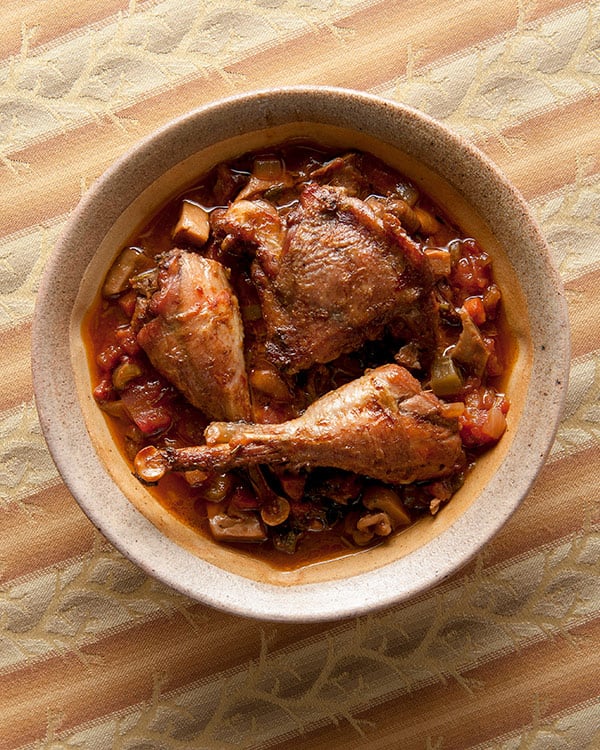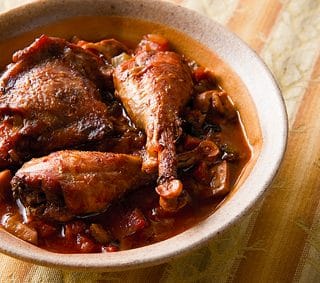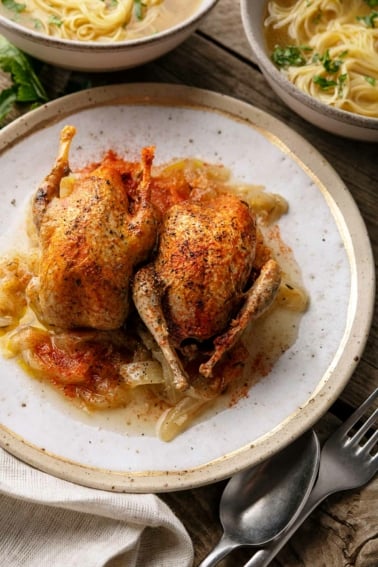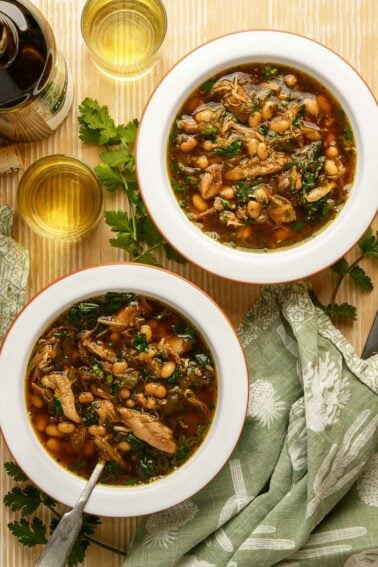As an Amazon Associate I earn from qualifying purchases.

I do a lot of comfort food with big, flavorful, stew-y things loaded with tomatoes and herbs and some sort of meat. In this case the meat is pheasant, and what better dish than pheasant cacciatore?
Hunter’s style. The French call it chasseur, the Spanish cazadores, the Italians cacciatore. This dish in its variations exists in all three countries.
But it is usually done with chicken, which makes me wonder: Is this the meal the failed hunter gets from his wife when he returns empty-handed? “Oh, Enzo!” she cries. “I am so sad for you — I’ll go kill another chicken for dinner.” Is this a meal eaten in sullen reflection of missed shots, sore feet, or birds flushed just a little too far away?
Probably not. I do not know the actual history of hunter’s style chicken, but I am guessing it is an outgrowth of the 17th century — and was initially done with pheasants or partridges. If I am right, cacciatore is a fascinating amalgam — tomatoes imported from the New World, pheasants from China.
Another possibility is that this is what the housewife (or servant, more likely, given the European hunting tradition), stewed for several hours while the hunters were out chasing pheasants or deer, making this chicken stew a welcome-home meal. If anyone has any insight into the history of cacciatore, I’m all ears.
What makes chasseur or cacciatore or cazadores unique? As far as I can tell, it requires these things:
- A white meat, such as chicken, pheasant or rabbit
- White wine
- Tomatoes
- Mushrooms
- “Woodsy” herbs such as sage and rosemary
This dish is so satisfying, the way only the combination of tomatoes, wine, mushrooms and meat can be. I’d used pheasant legs and wings from birds that had hung for three days, and they were tender and deeper-tasting than any pheasant I’d eaten before. So I can happily say my experiment with hanging pheasants has, thus far, been a success.
Could you use chicken here? You bet, but please do your best to locate a stewing hen; try a Mexican or Asian market. These older hens taste better and can stand up to stewing better than the fryers or roasters, which in my opinion are too young.
What sort of mushrooms? A variety. Buttons are fine, but bolster them with some good dried ones. What sort of wine? A dry white: Think Pinot Grigio rather than a buttery Chardonnay. Herbs? Definitely sage and rosemary, but you could play with thyme, savory, oregano and parsley, too.
Finally, you must — must — have good bread to eat with your pheasant cacciatore. If you are really hungry, add a big dollop of polenta, too. Buon appetito!
Pheasant Cacciatore
Ingredients
- 2 pheasants, cut into serving pieces
- 1/4 pound pancetta or 4 strips bacon
- 3 tablesppons olive oil (or pheasant or chicken fat)[/ingredient]
- 1 chopped celery stalk
- 1 chopped carrot
- 5 cloves chopped garlic
- 1 onion, sliced into half-moons
- 1 quart crushed tomatoes
- 2 cups white wine
- 1 tablespoon chopped fresh sage
- 1 tablespoon chopped fresh rosemary
- 1 teaspoon crushed juniper berries (optional)
- 4 bay leaves
- 1/2 ounce dried mushrooms (about a handful)
- 1/2 pound fresh mushrooms, any kind
- Salt and pepper to taste
- 4 tablespoons minced parsley
Instructions
- Preheat oven to 350°F. If using, cut the pancetta into little batons about 1/4 inch thick. In a large braising pan or Dutch oven, heat 2 tablespoons olive oil or pheasant or chicken fat over medium heat and cook the pancetta or bacon. Remove and reserve.
- Add the pheasant pieces and brown them well. Take your time and do it in batches. Remove the pheasant pieces as they brown. Add the carrot, celery, onions and the fresh mushrooms and turn the heat up to high. Sauté them until the onions are wilted and are beginning to brown. Add more oil if needed. When they begin to brown, add the garlic and cook for another 1-2 minutes, stirring occasionally.
- Add the herbs and the dried mushrooms and the white wine and turn up the heat to maximum. Stir well. Let the wine cook down by half. Add the tomatoes and mix well. Add some salt if needed. Add the bacon and the pheasant pieces, skin side up. Do not submerge the pheasant, just nestle the pieces into the sauce so the skin stays out of the liquid.
- Cover and cook in the oven for 45 minutes. Check to see of the meat is thinking about falling off the bone. Sometimes with a young pheasant all it takes is 45 minutes. An hour or more is typical. When the meat is as tender as you want, remove the cover from the pot and cook until the skin crisps, about 30-45 more minutes.
- Move the pheasant pieces to a plate. Add the parsley to the pot and mix to combine.
- To serve, ladle some of the sauce out, top with a pheasant piece and serve with either polenta or a good crusty bread. I like a dry rose or a light red like a Sangiovese for this dish.
Notes
Nutrition
Nutrition information is automatically calculated, so should only be used as an approximation.






Hank,
My father was born in the Calabria region of Italy in 1921. He always insisted that cacciatore
does not have tomatoes in it, and he never saw cacciatore with tomatoes until he came to the United States. The story he told was that hunters would go out with a pocketful of herbs and would cook up their catch in the field. They would often gather mushrooms to add to it, and if they had some wine to put in the pot, so much the better. But a hunter would not carry tomatoes afield. He also,said that rabbitt was the most common meat cooked this way. I don’t know about the accuracy of this but my grandmother used to cook rabbitt (and sometimes chicken) cacciatore and it never had tomatoes in it.
Ponzio: Very cool! Never heard that.
Wow.! All these years past and I never thought of drooping pheasant into my cacciatore recipe…it has now become my new favorite pheasant recipe.
Thanks Hank!
Great recipe for game club pheasants, as advertised. Used it yesterday to cook up some sinewy-legged birds that were shot on Monday. After 1.5 hours, the meat wasn’t quite falling off the bone, but at least it was tender and way more edible than the pheasant legs I roasted on Tuesday which had sinews like rubber bands. Had to stop cooking at a little over 2 hours because (1) the sauce was perfection at that point and (2) it was 11 o’ clock at night which is kind of late to be eating dinner.
Only change I made to the recipe — other than not using juniper berries, because I couldn’t find any at Raley’s — was to do the braising on a gas range instead of in the oven. Not because I thought it would work better, I just don’t own an oven-proof braising pan or Dutch oven. So I treated the cacciatore the same way I would beef bourguignon or coq au vin, which is to cover and simmer for several hours. Seemed to work okay, though I couldn’t crisp the skin.
Anyway, thanks for posting this very useful recipe!
Christian: Yep. Skinless pheasant will work, but I would save the breasts for another dish and just use the legs and wings here.
Hank,
A buddy just gave me some pheasants he shot in South Dakota this Fall. Unfortunately, they have all been skinned. Will skinless Pheasant work alright for this recipe or should I go in a different direction.
Had a couple of birds from South Dakota and was looking for a new way to cook them when google sent me to this recipe. It was absolutely to die for ! the sauce could work for a lot of different birds thanks
Thanks for the inspiration. Unlike most of California, there is plenty of winter left in Michigan. This past Saturday afternoon I saw your recipe and decided to pull a couple of Montana roosters from the deep freeze to make for Sunday dinner.
I followed your recipe to the letter, other than I didn’t have any juniper berries handy so I added a half shot of gin when I put in the wine. I wished that I still had dried morels left, but they’re long gone so I had to make due with dried Porcinis from the store.
The birds I used were mislabeled and I ended up with couple of long-spurred brutes rather than the young-of-the-year that I intended. I just extended the cook time to ninety minutes and everything was good. They never quite got to the falling off the bone stage, but they were quite tender, even the legs.
I served it with some fresh made French bread and oven roasted butternut squash with butter and a touch of cinnamon. We had guests for dinner who’d never had wild pheasant before and I got one convert for sure.
I’m looking forward to test driving some of your duck recipes on the plucked and waxed late season mallards currently resting in the deep freeze. To date, my standard treatment for all waterfowl is a brine bath followed by a trip to the smoker. I’ve had fellow hunters and anglers nearly come to blows fighting over the last smoked Canada goose thigh, slippery with cold goose fat.
I didn’t break out the camera while I was cooking, but here’s a few shots of the roosters before plucking.
https://picasaweb.google.com/brbrenton/Montana2008#
Some additional speculation:
https://almostitalian.com/chicken-alla-cacciatora/
Hank
Thanks for the inspiration. Returned from the Dakotas and Montana with a bunch of pheasants. I will pull a couple out of the freezer.
The Porcini mushrooms (good idea) and a stock from a carcass would add even more richness. Thanks!
Hank, indeed; maybe I should read the recipe *before* posting a comment…
Anyway, you inspired me. We had a bunch of stuff getting old in the fridge just waiting to be turned into a version of the hunter’s dinner. I might make a post out of it…if I can salvage pics…we got a little into our cups in the process…You know, Wednesday night and all!
Lang: Great minds and all that — I do indeed use dried porcini in my recipe!
Heather: Not sure about capons, as they remain really tender despite their size…side effect of the whole castration thing. And have no fear, you live in the Pacific Northwest — it will be cummy again in no time!
Peter: Kokkoros Krassatos, eh? I’ll add that to the list. Thanks!
Karen: Dunno about the images. As for the history, yeah, I’ve read that, too, but I am pretty skeptical about the anecdotes that supposedly spawned dishes. For now it’ll have to do though.
Adele: Interesting point. Maybe the figurative “Hunter’s Style:” is shorthand for the use of “woodsy” herbs like thyme, rosemary and sage, plus forest mushrooms…
Good stuff! I fired up some pheasant cacciatore a few weeks back. But the I used skinless breasts so it was lacking a bit.
What Hank didn’t mention is how we three huntresses shamelessly devoured seconds and thirds the night he made this. It was deeply satisfying, and far more delicious than pheasant usually tastes to me.
As much as I enjoy the mental image of your first scenario, I suspect the second is more accurate.
Then again, it’s possible that the name actually has nothing to do with real hunters. Chicken scarpiello, for example, is chicken “cobbler’s style,” and it’s called that because the chicken is cut into small pieces on the bone, and the act of eating the pieces is reminiscent of the way the cobbler holds nails in his mouth.
This looks better then my rabbit version! Looks great!:)
I’ll take a look at the recipe. Why is it that I can’t see your photos on your blog? Is it me? Oh, you had me curious about the history of the name. I looked it up: “The dish originated in the Renaissance period (1450-1600) when the only people who could afford to enjoy poultry and the sport of hunting were the well-to-do.” So there you have it 🙂
Hank, you can add Kokkoros Krassatos as the Greek answer to such a dish.
Your use of pheasant in this application, would love to have a hunter such as yourself nearby.
It could be like Welsh rarebit (really, Welsh rabbit).
I just realized recently that some regular groceries carry capons in the freezer section. If I were going to an Asian grocery I’d prolly just get some quails or a duck.
This is a gorgeous stew, Hank. If it weren’t threatening to become spring any day now, I’d whip one up tonight. Maybe it’ll get crummy again by the weekend.
Poor Enzo! But I could eat this dish every night, pheasant or not. Dried porcini would give it a solid bass note, too.
Cheers,
Lang (Finspot)